|
 Humidicutis multicolor Humidicutis multicolor
SynonymsHygrophorus multicolor
Hygrocybe multicolor
BiostatusPresent in region - Indigenous. Non endemic
Images (click to enlarge)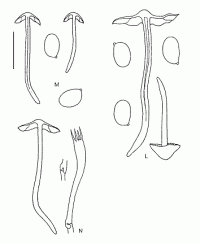
Caption: Fig. 48 Humidicutis multicolor (Berk. & Br.) Horak. (I-N:
ZT 1018): L. basidiomes. M. spores. N. basidia.
| 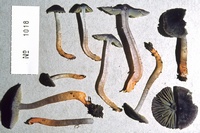
Caption: ZT1018
Owner: E. Horak: © Creative Commons Attribution-Noncommercial 3.0 New Zealand | 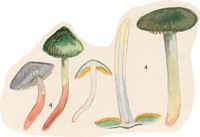 | 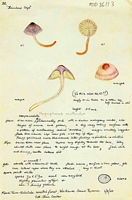
Caption: Watercolour
Owner: G.M. Taylor | 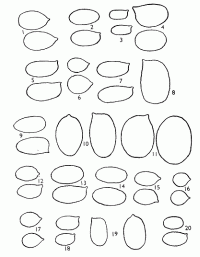
Caption: Spores X 2000 1. Hygrophorus salmonipes 2; H. elsae; 3, H .julietae; 4, H. variabilis; 5, H. lilaceo-lamelllatus; 6, H. muritaiensis; 7, H. keithgeorgei; 8, H. pseudococcineus; 9, H. rubro-carnosus; 10, H. miniceps; 11, H. procerus; 12, H. multic |
Article: Stevenson, G. (1963) [1962]. The Agaricales of New Zealand: IV. Kew Bulletin 16(3): 373–384.
Description: Pileus 1.5-3.5 cm. diam., green to dark green, rarely blue, darker at centre,
matt to finely fibrillose, campanulate to broadly hemispherical, becoming plane;
flesh blue. Gills adnexed to free, or adnate with a decurrent tooth, moderately
distant, green with yellow margins. Stipe 3-6 cm. X 3-6 mm., sky blue or greenish
above, shading through yellow to orange at base, hollow, silky, smooth; flesh
blue above, yellow to orange below. Spores 7-8 X 5-5.5 µm., ovoid, hyaline,
print white. Basidia 35 X 6-7 µm., four spored.
Habitat: habitat: terrestrial
under scrub and forest, Eastbourne, 4.6.1949; Wellington Botanic Garden, 26.5.1949
& 9.6.1949; Levin, 22.6.1958; all Stevenson.
Notes: Although the original description is rather meagre it gives these striking colour characteristics
so that the writer refers her collection to this species. There is no specimen
at Kew but there is a drawing showing a somewhat faded example. Spore dimensions
were not given in the original description.
Article: Horak, E. (1971). A contribution towards the revision of the Agaricales (Fungi) from New Zealand. New Zealand Journal of Botany 9(3): 403-462 (http://www.rsnz.org/publish/abstracts.php).
Notes: Stevenson's description of this species is based on two different collections
which we also have studied. Not only are the spore dimensions of the two
collections widely different but we believe that neither of them can be identified
with H. multicolor.
Article: Horak, E. (1990). Monograph of the New Zealand Hygrophoraceae (Agaricales). New Zealand Journal of Botany 28(3): 255-306 (http://www.rsnz.org/publish/abstracts.php).
Description: Pileus -45 mm, hemispherical, convex or umbonate-expanded; dark green to green-olive
when young turning blue-green or lilac-green with age; dry, minutely fibrillose,
silky, margin splitting in mature specimens, hygrophanous, membranaceous. -
Lamellae 12-18 (1-3) adnate to emarginate, subdecurrent with short tooth, ventricose,
up to 5 mm wide; olive-green at first changing to lilac or bluish, entire edges
concolorous or orange. - Stipe 25-75 x 2-5 mm, cylindrical, equal or subattenuate
towards base; pale green-blue-lilac at apex, brilliant orange towards and at
base; dry, fibrillose, silky, hollow, fragile, single or caespitose. –Context
blue in pileus, pale blue-green in upper portion of stipe, orange in base of
stipe, brittle. – Odour and taste not distinctive. - Chemical reactions on pileus:
KOH - yellow.
Spores 5.5-7 x 4-5 um, ovoid. - Basidia 20-45 x 6-7 um, 4-spored, with medallion-like
clamp connection at basal septum. - Cystidia absent. - Pileipellis a cutis of
repent, cylindrical hyphae (25 um diam.), membrane not gelatinised, with yellow
(KOH) plasmatic and encrusting pigment, subcutis composed of fusoid to ovoid
cells; clamp connections absent on cuticular hyphae (Pl. 1, Fig. 8).
Habitat: ECOLOGY: Scattered; saprobic on soil among litter in broadleaved-conifer forests
(dominated by Dacrydium cupressinum) or in Nothofagus fusca-Kunzea
ericoides-Leptospermum scoparium forests, March-June.
Distribution: DISIRIBUTION: NZ (NA, W, WL). - South America (Argentina, Tierra del Fuego),
cf. Horak (1979: 57) - Sri Lanka (type), cf. Pegler (1986: 52).
Notes: The original description of Humidicutis multicolor; is based upon specimens
collected in Sri Lanka. According to Pegler (1986: 52) the type material of
this mul6coloured agaric is lost and hence its taxonomic identity and interpretation
remain unsettled.
In the present species concept the type of H multicolor is not considered a
synonym of the sympatric Ceylonese Camarophyllus caesius (Berk & Br.) as
suggested by Pegler (1986). The three New Zealand collections referred to H.
multicolor are in complete agreement with material gathered and published
under this name from Tierra del Fuego (Horak 1979: 57).
|